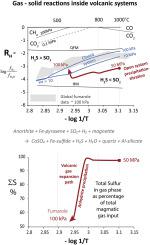Journal of Volcanology and Geothermal Research ( IF 2.4 ) Pub Date : 2021-01-19 , DOI: 10.1016/j.jvolgeores.2021.107181 Richard W. Henley , Tobias P. Fischer

|
Although It has long been recognized that sub-volcanic gas-solid reactions involving iron play a major role in determining the redox state () of discharging gases, the crucial role played by calcium has only recently been recognized through high temperature gas-solid experimental studies.
These show that SO2, which dominates H2S in high temperature (> ~600°C) volcanic gas mixtures, rapidly and efficiently reacts with abundant plagioclase and other calcic rock-forming minerals to simultaneously deposit anhydrite and release reduced sulfur. Coupled with sulfide deposition, these reactions control the total sulfur content of the gas phase through the very low solubilities of sulfides and anhydrite and, via coupled multicomponent reactions, determine the redox state and the H2S/SO2 ratio of the volcanic gas mixtures.
Multi-component thermochemical modelling of gas-solid equilibria and titration-precipitation reactions along adiabatic expansion pathways from magma to surface confirm that for fumarole gas mixtures with outlet temperature > 400 °C, RH is primarily controlled by anorthite - pyroxene - anhydrite - sulfide reactions, irrespective of their tectonic location, state of volcanic activity, gas discharge temperature and the composition of the gas mixtures released from the magma.
Anhydrite and sulfide deposition through gas-solid reactions result in extensive sulfur sequestration as gas mixtures expand from the magma to the surface as is observed in the many large scale ‘porphyry’ Cu-Mo-Au deposits exposed in ancient, now dissected, volcanoes in magmatic arcs. These volcano-scale alteration processes also imply that high temperature (> 600 °C) volcanic gases have C/S ratios that may have been increased by this process relative to their original magmatic values. The corollary is that current estimates of the total sulfur released annually from the mantle may be significantly underestimated.
中文翻译:

火山气体中的硫固存和氧化还原平衡
尽管早就认识到,涉及铁的次火山气固反应在确定氧化还原状态中起着重要作用()排放气体,直到最近才通过高温气固实验研究认识到钙所起的关键作用。
这些结果表明,在高温(>〜600°C)的火山气体混合物中占主导地位的H 2 S的SO 2与大量斜长石和其他钙质成岩矿物迅速有效地反应,从而同时沉积硬石膏和释放还原的硫。这些反应与硫化物沉积结合,通过非常低的硫化物和硬石膏溶解度控制气相的总硫含量,并通过偶联的多组分反应,确定火山气体混合物的氧化还原态和H 2 S / SO 2比。
气体-固体平衡和沿绝热膨胀路径从岩浆到地表的滴定-沉淀反应的多组分热化学模型证实,对于出口温度> 400°C的富马酚气体混合物,R H主要受钙长石-辉石-硬石膏-硫化物的控制反应,无论其构造位置,火山活动状态,气体排放温度以及从岩浆中释放出的气体混合物的成分如何。
由于气体混合物从岩浆扩展到地表,气固反应中的硬石膏和硫化物沉积导致大量的硫固存,正如在古代(现已解剖)的火山中暴露的许多大型“斑岩” Cu-Mo-Au矿床中所观察到的那样。岩浆弧。这些火山规模的变化过程也暗示着高温(> 600°C)的火山气体具有C / S比,相对于其原始岩浆值,该过程可能已经提高了C / S比。结果是,目前估计每年从地幔释放的总硫量可能被大大低估了。











































 京公网安备 11010802027423号
京公网安备 11010802027423号